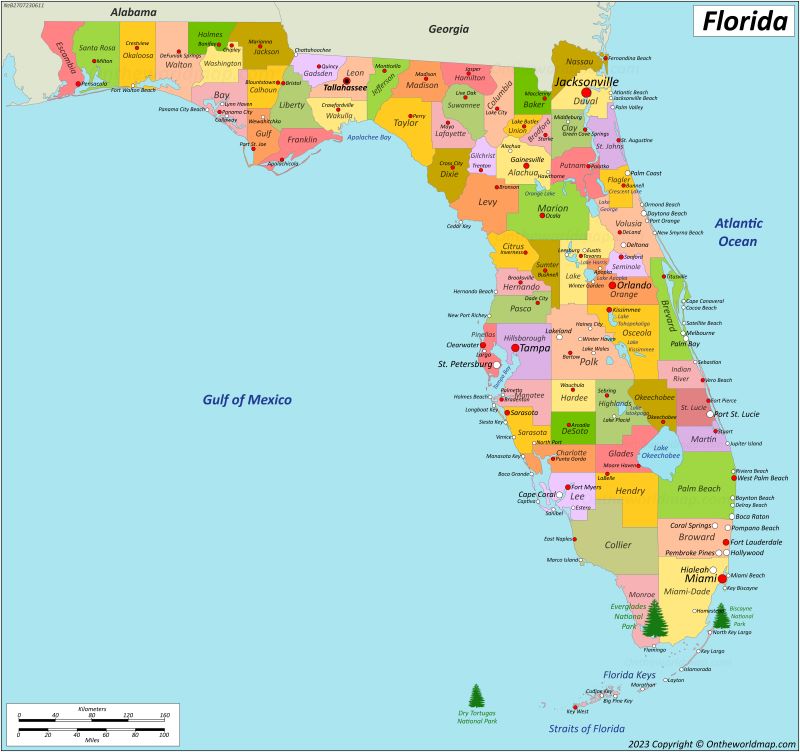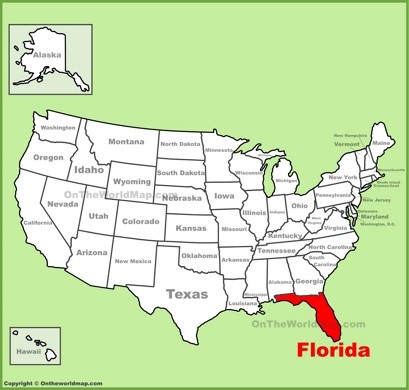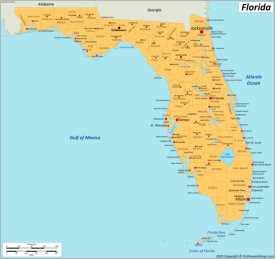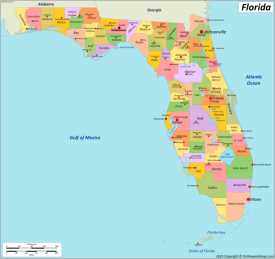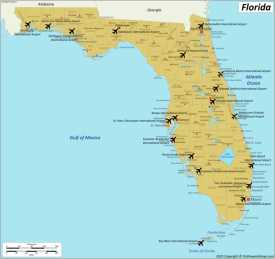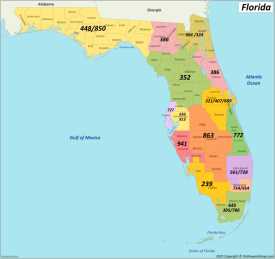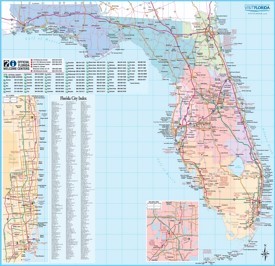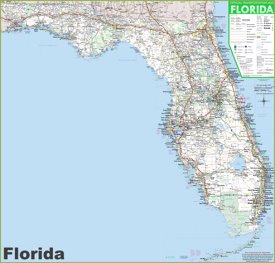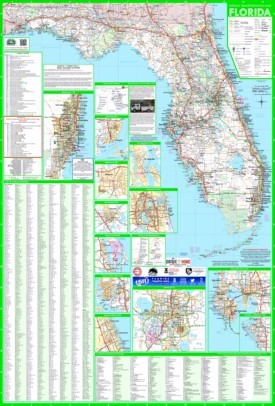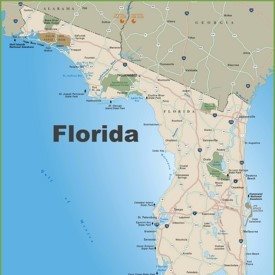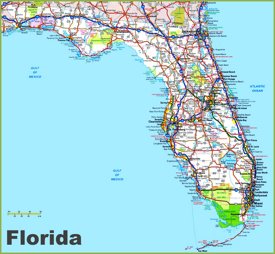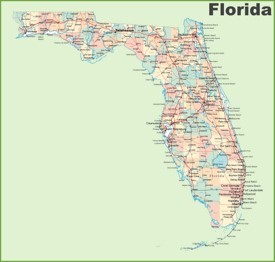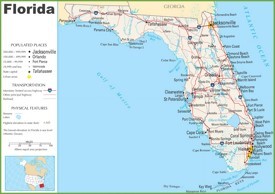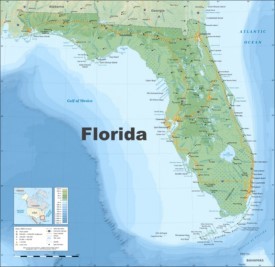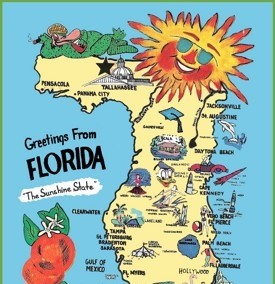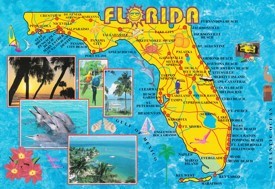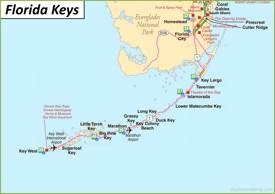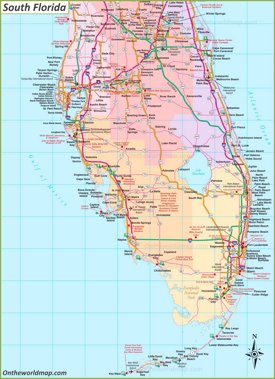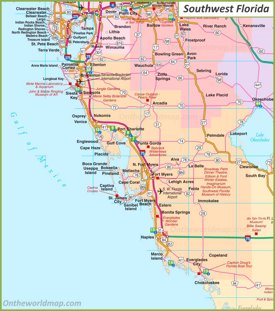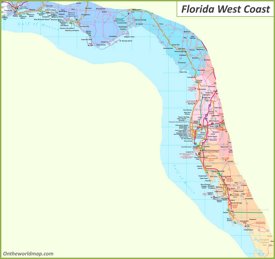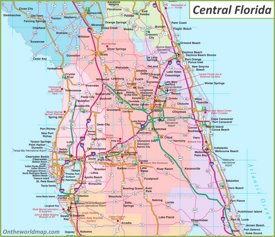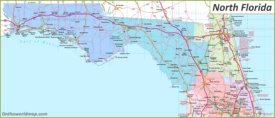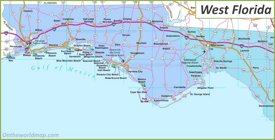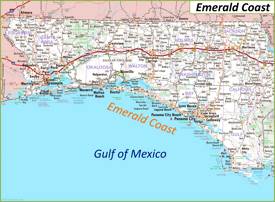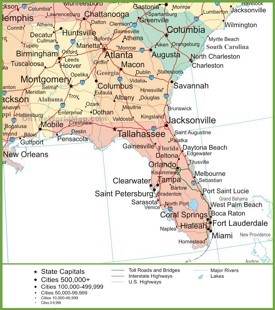Florida Map
Description:
This map shows states boundaries, islands, lakes, the state capital, counties, county seats, cities, towns and national parks in Florida.
Size: 1600x1504px / 728 Kb
Author: Ontheworldmap.com
You may download, print or use the above map for educational, personal and non-commercial purposes. Attribution is required. For any website, blog, scientific research or e-book, you must place a hyperlink (to this page) with an attribution next to the image used.
Florida Location Map
Online Map of Florida
Detailed Maps of Florida
Maps of Florida Regions
Maps of Florida and Neighbouring States
Other Maps of Florida
Google Map of FloridaOpenStreetMap
Bing Maps
USGS National Map
Florida National Map (National Atlas of the United States)
About Florida
The magnificent state of Florida is strategically positioned in the southeastern region of the United States, bordered by the shimmering waters of the Gulf of Mexico to the west and the vast Atlantic Ocean to the east. Its northern boundaries are shared with the state of Georgia, while the northwestern border connects with Alabama. The picturesque Straits of Florida create a natural maritime boundary that separates the peninsula from the island nations of Cuba and The Bahamas, contributing to Florida's unique geographical identity as a gateway between North America and the Caribbean.
The historic city of Tallahassee proudly serves as Florida's capital. The state boasts several major metropolitan centers, each with distinctive characteristics. Miami stands out for its profound cultural diversity and significant economic influence throughout the Americas, while Orlando has earned worldwide recognition for its expansive theme parks and thriving entertainment industry. Tampa functions as a crucial commercial hub on the Gulf Coast, and Jacksonville, Florida's most populous urban center, holds the distinction of being the largest city by area in the contiguous United States. These vibrant cities collectively serve as essential economic powerhouses, cultural melting pots, and sophisticated logistical centers that drive the state's prosperity and global connectivity.
Florida has firmly established itself as a premier tourism destination of international caliber, consistently attracting tens of millions of visitors annually thanks to its idyllic tropical climate and extraordinary array of attractions. The Orlando metropolitan area alone generates massive tourism revenue through world-famous entertainment complexes including Walt Disney World, Universal Orlando Resort, and SeaWorld. Cosmopolitan Miami captivates visitors with its legendary nightlife scene, upscale shopping districts, and pristine beaches with turquoise waters, while the enchanting Florida Keys archipelago presents unparalleled opportunities for boating expeditions, sport fishing tournaments, and exploring vibrant coral reefs through snorkeling and diving. Nature enthusiasts are drawn to the state's remarkable ecological treasures, particularly the vast Everglades National Park, which showcases one of North America's most distinctive wetland ecosystems and offers exceptional wildlife viewing experiences featuring alligators, manatees, and hundreds of bird species.
Furthermore, Florida's impressive 1,350-mile coastline—the second longest in the United States—provides endless possibilities for water-based recreational activities, from leisurely swimming and professional surfing competitions to world-class deep-sea fishing expeditions in the Gulf Stream. The state's rich historical tapestry is beautifully preserved in locations such as St. Augustine, which holds the distinction of being the oldest continuously inhabited European-established settlement in the United States, founded in 1565. This remarkable blend of natural wonders, cultural diversity, and historical significance ensures that Florida delivers educational value alongside recreational enjoyment, creating memorable experiences for visitors of all ages and interests throughout its diverse regions.
The Facts:

Great Seal of the State of Florida |

Flag of Florida |
| Capital: | Tallahassee |
| Largest city: | Jacksonville |
| Area: | 65,758 sq mi (170,312 sq km) [1] |
| Dimensions: |
|
| Latitude: | 24° 27' N to 31° 00' N |
| Longitude: | 80° 02' W to 87° 38' W |
| Population (2024): | 23,372,215 [2] |
| Density: | 414.8/sq mi (160/sq km) |
| Elevation: | |
| Official language: |
|
| Spoken language:[4] |
|
| Religion in Florida (2014):[5] |
|
| Racial/ethnic groups (2024):[1] |
|
| Median household income (2023): | $71,711[1] |
| USPS abbreviation: | FL |
| ISO 3166 code: | US-FL |
| Time zone: | Peninsula and "Big Bend" region - UTC−05:00 (Eastern) - Summer (DST) - UTC−04:00 (EDT) Panhandle west of the Apalachicola River - UTC−06:00 (Central) - Summer (DST) UTC−05:00 (CDT) |
| Official website: | www.myflorida.com |
List of The Largest Cities in Florida by population
| Rank | City | County | Population (2020)[6] |
|---|---|---|---|
| 1 | Jacksonville | Duval | 949,611 |
| 2 | Miami | Miami-Dade | 442,241 |
| 3 | Tampa | Hillsborough | 384,959 |
| 4 | Orlando | Orange | 307,573 |
| 5 | St. Petersburg | Pinellas | 258,308 |
| 6 | Hialeah | Miami-Dade | 223,109 |
| 7 | Port St. Lucie | St. Lucie | 204,851 |
| 8 | Tallahassee | Leon | 196,169 |
| 9 | Cape Coral | Lee | 194,016 |
| 10 | Fort Lauderdale | Broward | 182,760 |
| 11 | Pembroke Pines | Broward | 171,178 |
| 12 | Hollywood | Broward | 153,067 |
| 13 | Gainesville | Alachua | 141,085 |
| 14 | Miramar | Broward | 134,721 |
| 15 | Coral Springs | Broward | 134,394 |
| 16 | Palm Bay | Brevard | 119,760 |
| 17 | West Palm Beach | Palm Beach | 117,415 |
| 18 | Clearwater | Pinellas | 117,292 |
| 19 | Lakeland | Polk | 112,641 |
| 20 | Pompano Beach | Broward | 112,046 |
| 21 | Miami Gardens | Miami-Dade | 111,640 |
| 22 | Davie | Broward | 105,691 |
| 23 | Boca Raton | Palm Beach | 97,422 |
| 24 | Sunrise | Broward | 97,335 |
| 25 | Deltona | Volusia | 93,692 |
List of Cities in Florida Alphabetically
Florida Beach Towns
Map of the best beaches in Florida
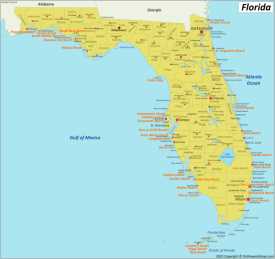
Main sights in Florida
- Duval Street (Key West)
- Everglades National Park
- Dry Tortugas National Park
- Key Largo
Counties of Florida
There are 67 counties in Florida, each functioning as a local administrative unit within the state. Miami-Dade, the most populous county, includes the city of Miami and serves as a major economic and cultural center. Broward County, home to Fort Lauderdale, ranks as the second most populous. Hillsborough County encompasses Tampa and functions as a key commercial hub.
In central Florida, Orange County contains Orlando, renowned for its major theme parks. Duval County, consolidated with the city of Jacksonville, stands as the largest by land area. The Panhandle features Escambia County and Bay County, significant for their naval and tourism industries, respectively.
List of counties in FloridaFlorida County Map
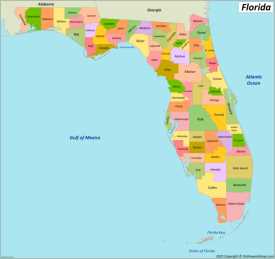
Regions of Florida:
- Florida Panhandle
- - Emerald Coast
- - Forgotten Coast
- - North Florida
- - Pensacola Area
- - Tallahassee Area
- North Central Florida
- - Big Bend
- - Nature Coast
- - North Florida
- - Gainesville Area
- Northeast Florida
- - First Coast
- - Jacksonville Area
- - North Florida
- Central West Florida
- - Nature Coast
- - Tampa Bay Area
- - Florida Suncoast
- Central Florida
- - Greater Orlando
- Central East Florida
- - Deltona–Daytona Beach–Ormond Beach Area
- - Surf Coast/Fun Coast/Halifax Area
- - Space Coast
- - Treasure Coast
- Southwest Florida
- - Florida Heartland
- - Florida Everglades
- - Florida Suncoast
- - Sarasota Area
- - Ten Thousand Islands
- South Florida
- - Everglades
- - Gold Coast
- - Florida Keys
- - Miami Area
List of National Parks in Florida
Florida National Parks Map
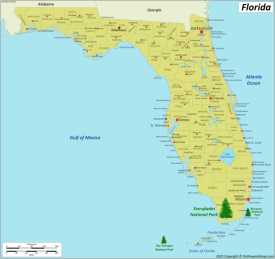
State Parks in Florida
Geography of Florida
The state of Florida occupies a peninsula between the Gulf of Mexico and the Atlantic Ocean, extending into the southeastern United States. It covers approximately 65,758 square miles, making it the 22nd largest state in the country. The terrain primarily consists of flat, low-lying plains, with the highest point, Britton Hill, reaching only 345 feet above sea level.
Florida numerous lakes, streams and rivers. The longest river, the St. Johns, meanders northward for 310 miles. The state's notable geological features include the Everglades, a vast subtropical wetland in the southern region, and the Florida Keys, a coral cay archipelago extending into the Straits of Florida.
The climate predominantly ranges from humid subtropical in the north to tropical in the southern and coastal regions. This climate supports a diverse ecosystem, boasting an array of flora and fauna, some unique to the state.
The eastern coastline faces frequent Atlantic hurricanes, while the western coastline contends with Gulf of Mexico storms. Florida's geographical setting, flat landscape, and extensive coastlines profoundly influence its climate, flora, fauna, and socio-economic activities, making it a distinctive region within the United States.
Islands of Florida
List of Islands of Florida Alphabetically
Major Rivers in Florida
- Suwannee River
- Saint Johns River
- Apalachicola River
- Withlacoochee River
- Kissimmee River
- Hillsborough River
- Ocklawaha River
- Peace River
- Myakka River
- Indian River
- Aucilla River
- Alafia River
- Caloosahatchee River
- Alapaha River
- Choctawhatchee River
- Ochlockonee River
- Santa Fe River
- Blackwater River
- Conecuh River
- Chipola River
- Yellow River
Lakes of Florida
- Lake Okeechobee
- Lake Kissimmee
- Lake Istokpoga
- Lake Tohopekaliga
- Crescent Lake
- Lake George
- Lake Apopka
- Lake Seminole
- Lake Talquin
- Lake Monroe
- Blue Cypress Lake
- Lake Harris
- Alligator Lake
- Lake Washington
- Lake Harney
Brief History of Florida
Florida's history dates back to its initial habitation by Native American tribes such as the Timucua and the Seminole. Spanish explorer Juan Ponce de León claimed it for Spain in 1513, naming it "La Florida." The state changed hands between Spain and Britain before the United States acquired it in 1821. Florida became the 27th state in 1845.
The state played a strategic role during the Civil War, siding with the Confederacy. Post-war reconstruction and the subsequent boom in tourism and agriculture, particularly citrus and cattle, accelerated its development. The mid-20th century saw rapid population growth due to air conditioning, the construction of the interstate highway system, and the establishment of Cape Canaveral as a space exploration hub.
Page Navigation
References
1. ^ QuickFacts Florida. United States Census Bureau.2. ^ U.S. Census Bureau QuickFacts Florida". U.S. Census Bureau, 2024 Estimate
3. ^ Elevations and Distances in the United States. 2001
4. ^ Modern Language Association
5. ^ Religious composition of adults in Florida
6. ^ United States Census Burea
U.S. Maps
Cities of USA
States of USA
States of USA

